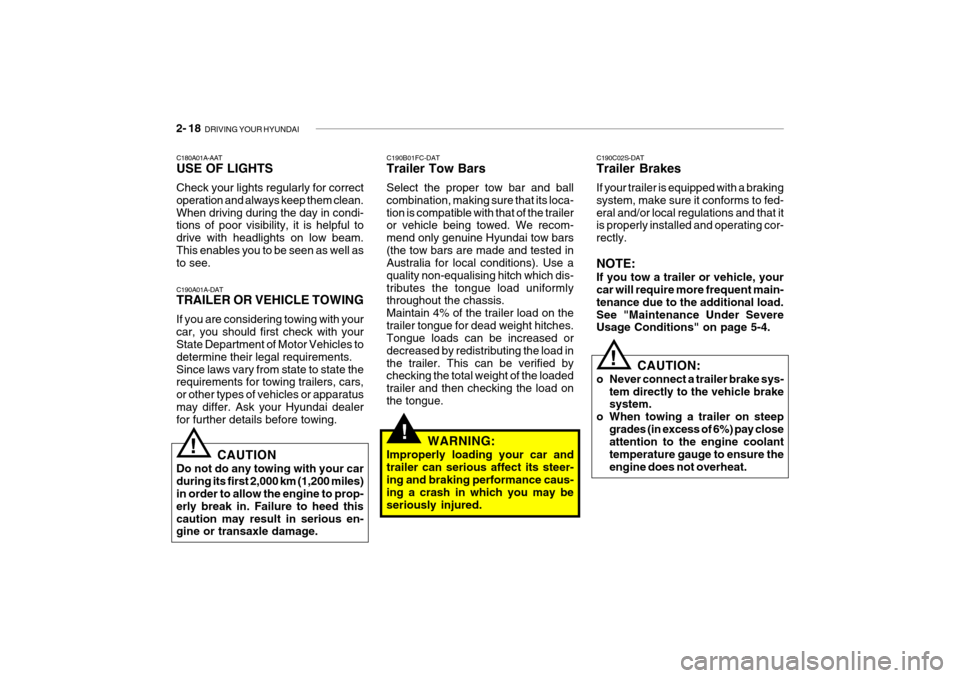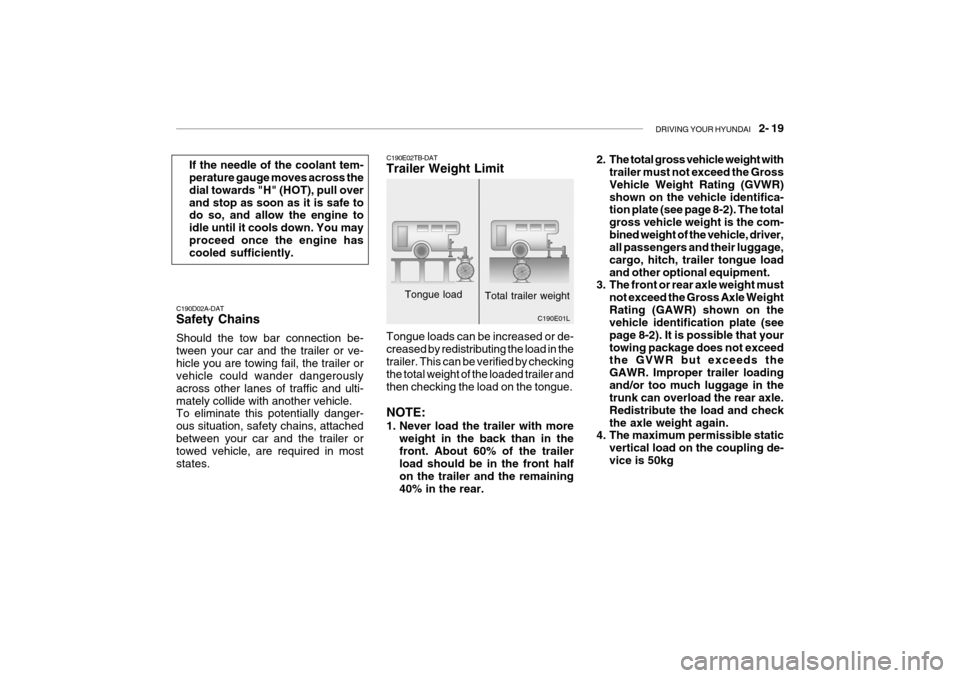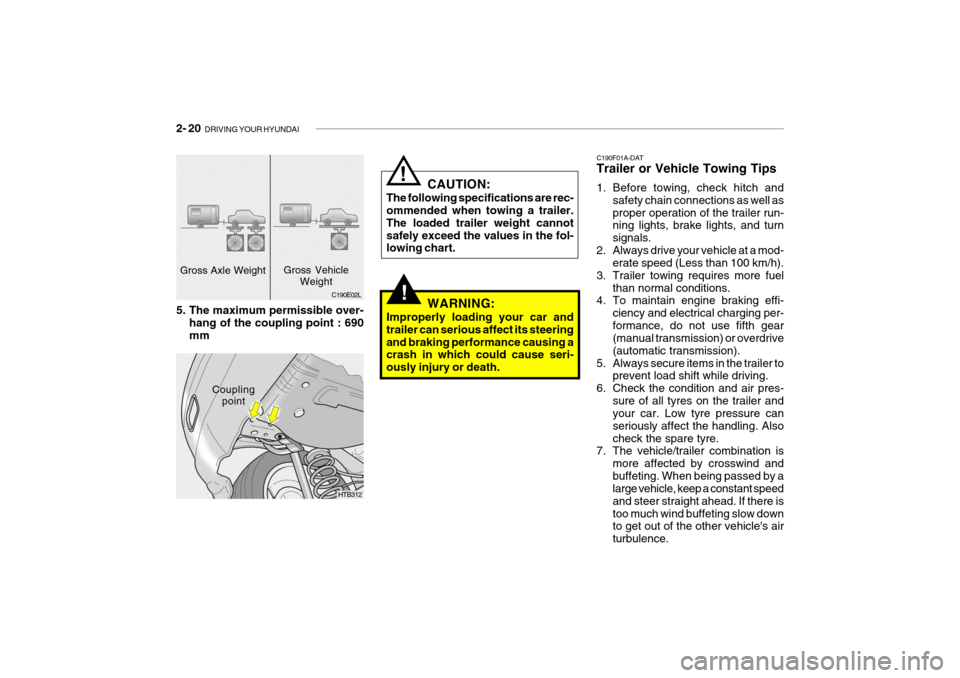2009 Hyundai Getz weight
[x] Cancel search: weightPage 23 of 191

1- 12 FEATURES OF YOUR HYUNDAI
To recline the seatback, lean forward to take your weight off it, then pull up on the recliner control lever at the outsideedge of the seat. Now lean back until the desired seatback angle is achieved. To lock the seatback into position,release the recliner control lever. WARNING:
To minimise risk of severe injury inthe event of a collision or a sudden stop, both the driver and passen- ger seatbacks should always be inan upright position while the ve- hicle is in motion. The protection provided by the seat belts andairbags may be reduced significant- ly when the seatbacks are reclined. There is greater risk that the driverand passenger will slide under the seat belt which may result in seri- ous injury if a crash occurs whenthe seatbacks are reclined. The seat belt cannot provide full protection to an occupant if the seat back isreclined.
HTB026-D
B080C01A-AAT Adjusting Seatback Angle
!
B080B01FC-GAT FRONT SEATS Adjusting Seat Forward andRearward
HTB024-D
!
To move the seat toward the front or rear, pull the lock release lever upward. This will release the seat on its track so you can move it forward or rearward to the desired position. When you find the position you want, release the lever and slide the seat forward or rearward on its track until it locks into the desired posi- tion and cannot be moved further.WARNING:
To ensure the seat is locked securely, attempt to move the seat forward or rearward without using the lock re- lease lever.
Page 110 of 191

DRIVING YOUR HYUNDAI 2- 15
C150A01A-AAT SMOOTH CORNERING Avoid braking or gear changing in cor- ners, especially when roads are wet. Ideally, corners should always be takenunder gentle acceleration. If you follow these suggestions, tire wear will be held to a minimum.
o Use your air conditioning sparingly.
The air conditioning system is oper-ated by engine power so your fueleconomy is reduced when you use it.
C160A01A-DAT WINTER DRIVING The more severe weather conditions of winter result in greater wear and other problems. To minimise the prob-lems of winter driving, you should fol- low these suggestions: C160B01A-DAT Snowy or Icy Conditions To drive your vehicle in deep snow, it may be necessary to use snow tyres orto install tyre chains on your tyres. If snow tyre are needed, it is necessary to select tyres equivalent in size andtype to the original equipment tires. Failure to do so may adversely affect the safety and handling of your car.Furthermore, speeding, rapid accel- eration, sudden brake applications, and sharp turns are potentially very haz-ardous practices. During deceleration, use engine brak- ing to the fullest extent. Sudden brakeapplications on snowy or icy roads may cause skids to occur. You need to keep sufficient distance between thevehicle in operation in front and your vehicle. Also, apply the brake gently. It should be noted that installing tyrechains on the tyre will provide a greater driving force, but will not prevent side skids. NOTE: Tyre chains are not legal in all states. Check state laws before fitting tyre chains.
o Keep your car clean all over. For
maximum service, your Hyundai should be kept clean and free of corrosive materials. It is especially important that mud, dirt, ice, etc. not be allowed to accumulate on the underside of the car. This extra weight can result in increased fuel con- sumption and also contribute to cor- rosion.
o Travel lightly. Don't carry unneces- sary weight in your car. Weight is an enemy of good fuel economy.
o Don't let the engine idle longer than
necessary. If you are waiting (and not in traffic), turn off your engine and restart only when you're ready to go.
o Remember, your Hyundai does not require extended warm-up. As soon as the engine is running smoothly, you can drive away. In very cold weather, however, give your engine a slightly longer warm-up period.
o Don't "labour" or "over-rev" the en- gine. Labouring is driving too slowly in too high a gear resulting in the engine bucking. If this happens to you, shift to a lower gear. Over- revving is racing the engine beyond its safe limit. This can be avoided by shifting at the recommended speeds.
Page 111 of 191

2- 16 DRIVING YOUR HYUNDAI
C160G01A-GAT To Keep Locks from Freezing To keep the locks from freezing, squirt an approved de-icer fluid or glycerineinto the key opening. If a lock is cov- ered with ice, squirt it with an approved de-icing fluid to remove the ice. If thelock is frozen internally, you may be able to thaw it out by using a heated key. Handle the heated key with careto avoid burning your fingers. NOTE: The proper temperature for using the immobilizer key is from -40°C to80°C. If you heat the immobilizer key over 80°C to open a frozen lock, it may cause damage to the tran-sponder in its head.
C160F01A-AAT Check Spark Plugs and Ignition System Inspect your spark plugs as described in Section 6 and replace them if neces- sary. Also check all ignition wiring and components to be sure they are notcracked, worn or damaged in any way.
C160E01A-AAT Change to "Winter Weight" Oil if Necessary In some climates it is recommended that a lower viscosity "winter weight" oil be used during cold weather. SeeSection 9 for recommendations. If you aren't sure what weight oil you should use, consult your Hyundai dealer.
C160C01A-AAT
Use High Quality Ethylene Glycol Coolant Your Hyundai is delivered with high quality ethylene glycol coolant in the cooling system. It is the only type ofcoolant that should be used because it helps prevent corrosion in the cooling system, lubricates the water pump andprevents freezing. Be sure to replace or replenish your coolant in accor- dance with the maintenance schedulein Section 5. Before winter, have your coolant tested to assure that its freez- ing point is sufficient for the tempera-tures anticipated during the winter. C160D01A-DAT Check Battery and Cables Winter puts additional burdens on the battery and charging system. Visually inspect the battery and cables as de-scribed in Section 6. The level of charge in your battery can be checked by your Hyundai dealer or a service station.
Page 113 of 191

2- 18 DRIVING YOUR HYUNDAI
!
C190C02S-DAT Trailer Brakes If your trailer is equipped with a braking system, make sure it conforms to fed-eral and/or local regulations and that it is properly installed and operating cor- rectly. NOTE: If you tow a trailer or vehicle, your car will require more frequent main- tenance due to the additional load.See "Maintenance Under Severe Usage Conditions" on page 5-4.
!
C190B01FC-DAT Trailer Tow Bars Select the proper tow bar and ball combination, making sure that its loca-tion is compatible with that of the trailer or vehicle being towed. We recom- mend only genuine Hyundai tow bars(the tow bars are made and tested in Australia for local conditions). Use a quality non-equalising hitch which dis-tributes the tongue load uniformly throughout the chassis. Maintain 4% of the trailer load on thetrailer tongue for dead weight hitches. Tongue loads can be increased or decreased by redistributing the load inthe trailer. This can be verified by checking the total weight of the loaded trailer and then checking the load onthe tongue.
WARNING:
Improperly loading your car andtrailer can serious affect its steer-ing and braking performance caus- ing a crash in which you may be seriously injured. CAUTION:
o Never connect a trailer brake sys- tem directly to the vehicle brake system.
o When towing a trailer on steep grades (in excess of 6%) pay closeattention to the engine coolant temperature gauge to ensure theengine does not overheat.
C180A01A-AAT USE OF LIGHTS Check your lights regularly for correct operation and always keep them clean.When driving during the day in condi- tions of poor visibility, it is helpful to drive with headlights on low beam.This enables you to be seen as well as to see. C190A01A-DAT TRAILER OR VEHICLE TOWING If you are considering towing with your car, you should first check with your State Department of Motor Vehicles to determine their legal requirements.Since laws vary from state to state the requirements for towing trailers, cars, or other types of vehicles or apparatusmay differ. Ask your Hyundai dealer for further details before towing.
!
CAUTION
Do not do any towing with your car during its first 2,000 km (1,200 miles) in order to allow the engine to prop- erly break in. Failure to heed thiscaution may result in serious en- gine or transaxle damage.
Page 114 of 191

DRIVING YOUR HYUNDAI 2- 19
C190E02TB-DAT Trailer Weight Limit
Tongue load Total trailer weight
C190E01L
Tongue loads can be increased or de- creased by redistributing the load in the trailer. This can be verified by checking the total weight of the loaded trailer andthen checking the load on the tongue. NOTE:
1. Never load the trailer with more weight in the back than in the front. About 60% of the trailer load should be in the front half on the trailer and the remaining40% in the rear. 2. The total gross vehicle weight with
trailer must not exceed the GrossVehicle Weight Rating (GVWR)shown on the vehicle identifica- tion plate (see page 8-2). The total gross vehicle weight is the com-bined weight of the vehicle, driver, all passengers and their luggage, cargo, hitch, trailer tongue loadand other optional equipment.
3. The front or rear axle weight must
not exceed the Gross Axle WeightRating (GAWR) shown on the vehicle identification plate (see
page 8-2). It is possible that yourtowing package does not exceed the GVWR but exceeds the GAWR. Improper trailer loadingand/or too much luggage in the trunk can overload the rear axle. Redistribute the load and checkthe axle weight again.
4. The maximum permissible static
vertical load on the coupling de-vice is 50kgIf the needle of the coolant tem- perature gauge moves across the dial towards "H" (HOT), pull overand stop as soon as it is safe to do so, and allow the engine to idle until it cools down. You mayproceed once the engine has cooled sufficiently.
C190D02A-DAT Safety Chains Should the tow bar connection be- tween your car and the trailer or ve-hicle you are towing fail, the trailer or vehicle could wander dangerously across other lanes of traffic and ulti-mately collide with another vehicle. To eliminate this potentially danger- ous situation, safety chains, attachedbetween your car and the trailer or towed vehicle, are required in most states.
Page 115 of 191

2- 20 DRIVING YOUR HYUNDAI
!
C190F01A-DAT Trailer or Vehicle Towing Tips
1. Before towing, check hitch and
safety chain connections as well as proper operation of the trailer run- ning lights, brake lights, and turn signals.
2. Always drive your vehicle at a mod- erate speed (Less than 100 km/h).
3. Trailer towing requires more fuel than normal conditions.
4. To maintain engine braking effi-
ciency and electrical charging per-formance, do not use fifth gear (manual transmission) or overdrive (automatic transmission).
5. Always secure items in the trailer to prevent load shift while driving.
6. Check the condition and air pres- sure of all tyres on the trailer and your car. Low tyre pressure can seriously affect the handling. Alsocheck the spare tyre.
7. The vehicle/trailer combination is
more affected by crosswind andbuffeting. When being passed by a large vehicle, keep a constant speed and steer straight ahead. If there istoo much wind buffeting slow down to get out of the other vehicle's air turbulence.
!
Gross Axle Weight
Couplingpoint C190E02L
Gross Vehicle
Weight
HTB312
5. The maximum permissible over-
hang of the coupling point : 690 mm CAUTION:
The following specifications are rec- ommended when towing a trailer. The loaded trailer weight cannotsafely exceed the values in the fol- lowing chart.
WARNING:
Improperly loading your car and trailer can serious affect its steeringand braking performance causing a crash in which could cause seri- ously injury or death.